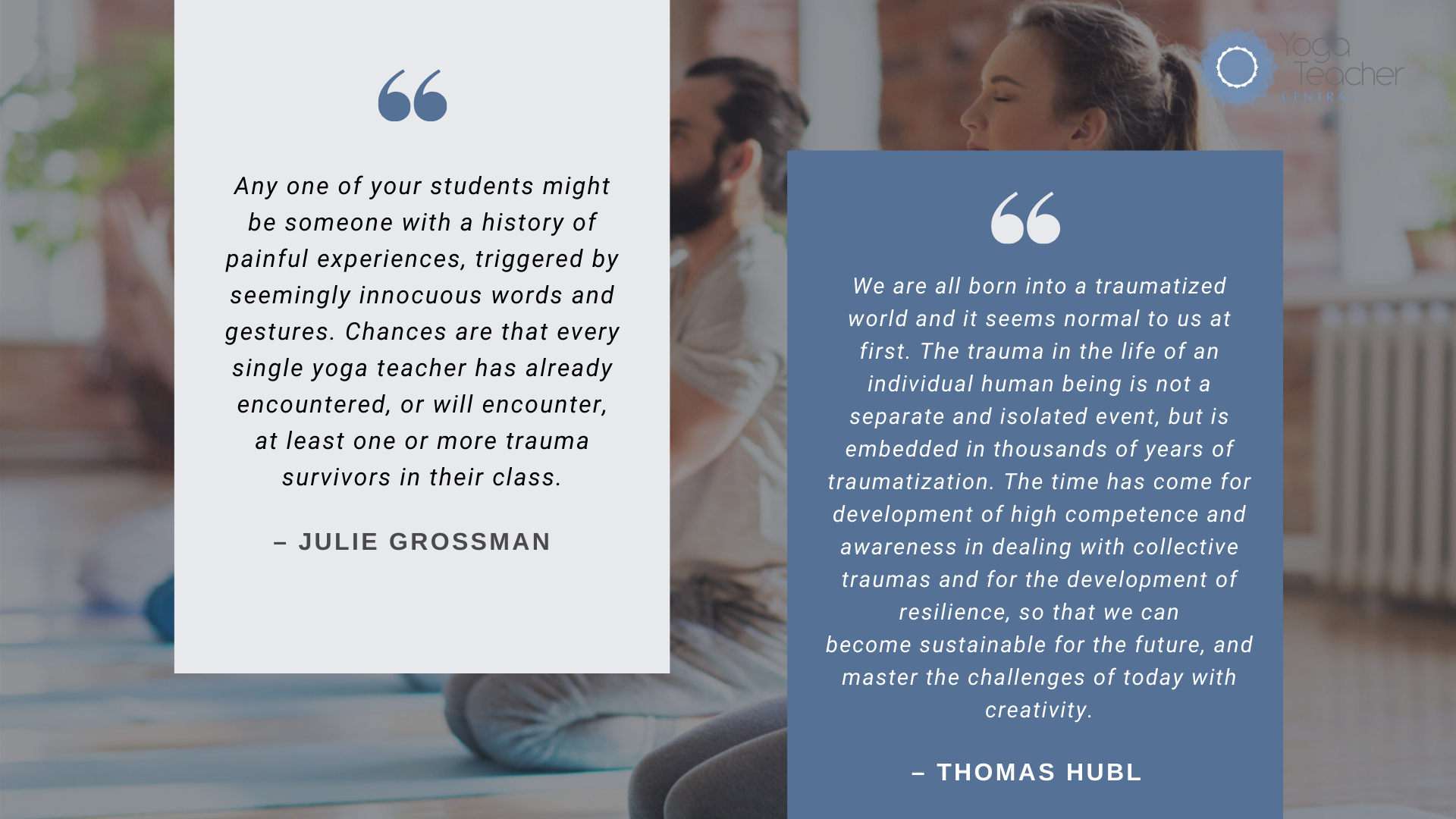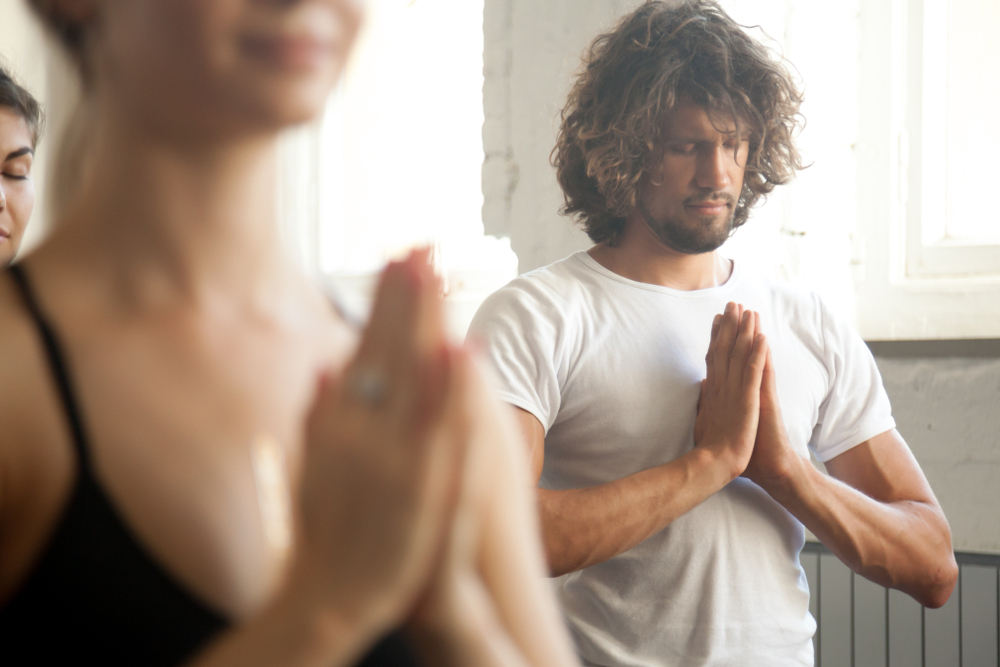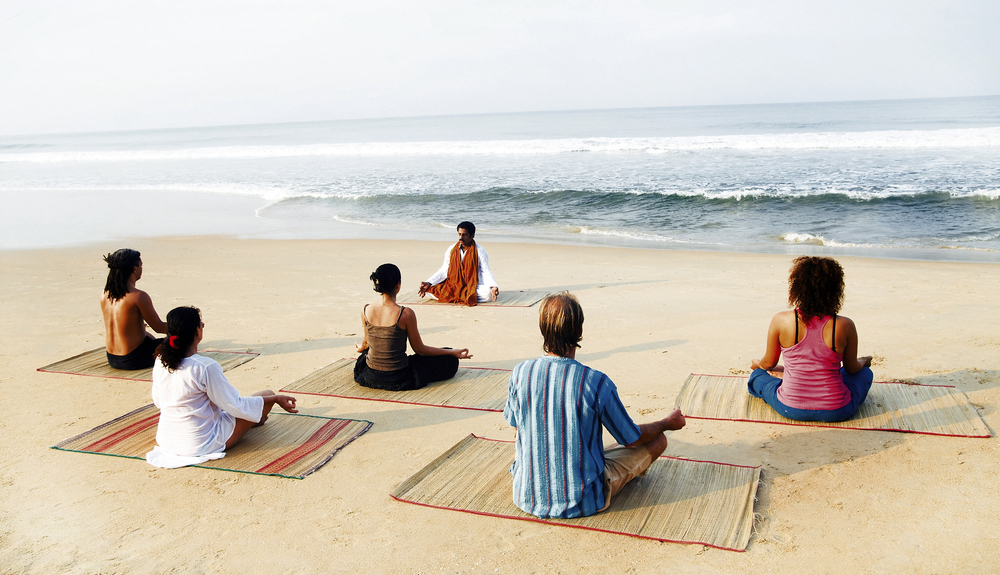

In this lesson, we apply knowledge of trauma effects to help identify triggers and to optimize teaching using a trauma-sensitive approach.
Objective
Become familiar with foundational considerations related to trauma-sensitive teaching, and review specific tactics for promoting emotional and psychological safety in the classroom.
Description
Explain why an awareness of trauma-sensitive teaching is useful and important for all yoga teachers. Describe the heart of trauma-sensitive teaching and provide trauma-sensitive teaching guidelines. Discuss the difference in approach when moving about the classroom in more common teaching vs. trauma-sensitive teaching. Provide considerations for verbalizing. Discuss touch from a trauma-sensitive perspective. Describe how to avoid causing common triggers. Explain clues that may indicate a student is being triggered and how you might respond. Give trauma-sensitive considerations related to Savasana.

Sometimes people think that a trauma-informed approach is only for people with major trauma. And yes, it is absolutely critical to teach with a trauma-sensitive lens when working with people experiencing acute trauma symptoms. But the truth is that we all hold and carry a lot in our bodies-minds-hearts. Trauma-informed yoga is for everyone, no exceptions. – Rosa Vissers, Executive Director of Yoga Behind Bars, Why I Teach Trauma-Informed Yoga
There is No “Look” to Trauma Survivors
How well do you know these characters from your class? The burly, muscle-bound man who is regularly complimented on his posing. The strapping yogini who was just directed to bend forward and exhale deeply. The soccer mom who seems at home in Lululemon, lingering by the door to chat before sneaking in late to class. The Zen, mala-wearing mama whose form was adjusted with a touch on the back (and the bra strap). How do you recognize when you are dealing with a survivor of trauma? This could be from sexual assault, domestic abuse, child neglect, or any sort of complex trauma. There is no single way they look, talk, or act. Any one of these people might be someone with a history of painful experiences, triggered by seemingly innocuous words and gestures. Chances are that every single yoga teacher has already encountered, or will encounter, at least one or more survivors in their class. – Julie Grossman, YogiTimes, 3 Ways to Make Your Yoga Class More Trauma Sensitive link
Research shows that successful trauma treatment requires healing the effects that trauma has caused in the body and nervous system. Thus, yoga can be an optimal tool in trauma healing and teachers have a prime opportunity to support students in their healing process.
Trauma-aware teaching will give you the skills to:


At the heart of trauma-sensitive teaching is granting complete student autonomy. Students are in charge of what they do with their body and how they interpret their feelings and experiences.
Some ways to communicate and uphold this vital priority include:
Following are more detailed considerations for each of these five topics.
Typical Yoga Classes Can Be Triggering to Survivors
There are many aspects of a typical yoga class that you might not even realize can be harmful or triggering for survivors of domestic violence and sexual assault — like facing away from the room’s entrance / exit or having an instructor circling around the room and touching you to correct your form without warning. – Laken Howard, Bustle, How Trauma-Informed Yoga Can Be Healing for Survivors of Domestic & Sexual Violence link

Behave in a way that acknowledges that some students may be carrying trauma and stress.

Empower students. Facilitate (not govern) their experience. Avoid any appearance of judgment or authority.
To use invitational language does not mean to be wishy-washy with instructions such as ending instructions with “if it feels good.” Rather, it means to invite students to self-reflect and make mindful choices. Learn more: Inclusive & Accepting Word Choice
To empower students rather than to exert power-over, and to respect the sovereignty of each individual student is at the heart of trauma informed teaching. You might find it interesting to acknowledge the greater context of society’s normalization and imposition of hierarchical control structures (through corporations, schools, military, government, etc). Empowering students is an example of making a different choice than to replicate systems of authority and power-over, seeking instead to facilitate and empower.
External Source of Authority vs. Choice-Making & Being One’s Own Authority
Throughout my years teaching, I’ve noted that a majority of teachers I’ve encountered were initially taught to teach by command. There are exceptions, of course, but it would appear that quite often, yoga classes take on the hierarchical model of many of our dominant cultural institutions, with an external source of authority (a teacher) telling a group of students what to do with their bodies. This strikes me as odd and discordant with the liberatory nature of yoga. It also does not offer opportunities for deep internal connection or the exacting of choice, instead reinforcing the power-over dynamics of dominant culture. I have yet to personally meet a teacher who doesn’t want their offerings to be welcoming, connective, and of-benefit to their students, and to do so, we need to reorient, create opportunities for active choice-making, and an environment that really serves the inward journey, allowing the student to be their own authority. We need to create cultures of consent. It is your responsibility as the teacher to engage in and model good consent practices before, during, and after your classes. Consent, briefly defined, is “permission for something to happen.” – M Camelia, Accessible Yoga, Creating Cultures of Consent in Yoga link

Take great care with space and touch.
Try teaching without any hands-on assists… it will, according to our study, help trauma survivors feel safer and more in control of their own body, both of which are key. – Overcoming Trauma through Yoga link

This is from an Off the Mat into the World email newsletter November 21, 2019:
When folks come onto the mat, we never know what they’re bringing with them– physical and sexual trauma, body dismorphia or folks with disabilities. Every Body is different. For many people, coming onto the mat and getting vulnerable in a class through body movement is a huge feat for them. It’s important we meet students where they’re at. That’s why we’ve created downloadable consent cards to print and distribute at your next yoga class.

Speak respectfully, clearly and mindfully, explicitly acknowledging autonomy of students to have their own experience.

Avoid common triggers and respond to apparent triggers with care.
Be aware if a student makes a comment or joke or appears uncomfortable or confused:
Acknowledging Potential Vulnerability
Some yoga poses can naturally be more triggering than others, like happy baby or downward dog, because of the potential vulnerability of exposing certain organs. You are certainly not expected to remove any potentially vulnerable pose from your class, yet consider the power of publicly recognizing how vulnerable certain poses or exercises can be and giving your students options to modify the pose or to sit it out all together. – Jamie Marich PhD, In the Rooms, Please Don’t Tell Me I’m in a “Safe Place” link

The Importance of “How” You Teach
Over the years, “what” I offer people has become much less important than “how.” How I am inviting people to make choices, how we are setting up the space, how I am encouraging people to explore sensations, how we balance predictability with curiosity—it’s all much more important than achieving a certain shape or completing a meditation exercise. – Rosa Vissers, Executive Director of Yoga Behind Bars, Why I Teach Trauma-Informed Yoga
Maximizing Students’ Psychological & Emotional Safety
Within the yoga service movement, it’s commonly understood that teachers committed to working with populations that have experienced high levels of trauma, such as homeless youth, recovering addicts, prisoners, veterans, and domestic violence survivors, need to be trained to teach in ways that maximize students’ psychological and emotional safety. Consequently, there’s a growing body of work offering insights and techniques regarding how to do this… The rest of the yoga community would benefit from following this example. Regardless of whether students represent a [traumatized] population or not, there needs to be more reflection on the psychological and emotional issues they’re likely to bring into the yoga classroom. At the same time, teachers need to engage in ongoing self-study to become more intimate with their own psychological and emotional patterning, and learn to work with it as best they can. – Carol Horton, PhD, Holding the Sacred Circle: Yoga Teachers and Emotional Safety link
Being Clear That the Student’s Experience is Her Own and is OK
For many individuals, particularly individuals who have been through trauma, the yoga practice can be uncomfortable at times. It is not easy to be present in your body, it doesn’t always feel good. In a normal regular class, if that is your experience and your teacher is telling you how amazing this pose should feel, you can feel like you are doing it wrong, you can feel shame. We tell our students that no matter their experience, it’s OK. Even lack of sensation in a pose, which is sometimes the experience of individuals who have been through trauma, is OK. – Laken Howard, Bustle, How Trauma-Informed Yoga Can Be healing for Survivors of Domestic & Sexual Violence link
Slow & Simple Movements Can Be Extremely Effective
Moving from one asana to another, slowly and deliberately, encourages students to stay with sensation and notice what’s happening in their bodies, and to approach each movement with a sense of curiosity. The simplest of poses (standing or sitting in a chair) can produce profound results. Just feeling his feet on the floor for the very first time gave one agitated survivor a sense of balance, stability, and safety… No matter what poses survivors choose to do—or how much they experiment with the breathing exercises—they benefit from knowing that each exercise comes to an end, that they won’t get stuck in emotional overwhelm… the sensations are temporary, only around until the next posture or the next exhalation. – Linda Sparrowe, Yoga International, Transcending Trauma: How Yoga Heals link
Caution Regarding Obtaining Consent for Touch
Many emotionally vulnerable folks believe that they have to say “yes” to you in order for you to like them. Thus, people may say it’s okay for you to touch them, yet… body language [may] suggest they are uncomfortable… If you can, approach students [outside of] class to verify their feelings about adjustments. – Dr. Jamie Marich, Decolonizing Yoga, 12 Simple Ways to Make Your Yoga Classes More Trauma Informed
Study Results: Trauma & Touch
Our National Institutes of Health (NIH) study [found] it is very common for adult clients to tell us that being touched by their children or intimate partners is one of the worst experiences in their lives exactly because they expect it to be enjoyable; they want to enjoy hugging and cuddling their loved ones but they can’t. Many of the women in our study told us that after 10 weeks of trauma sensitive yoga (that involved no touch), they were in fact able to be touched by their children and partners whereas before the yoga, touch had been unbearable. – David Emerson, Trauma-Sensitive Yoga in Therapy 2015 pgs 75-76 link
Reconsider the Phrase “Safe Space”
Whenever I’ve been told, as a survivor of trauma, that I’m in a safe place, my body tenses and my palms get sweaty. My entire visceral being longs to cry out, “Please don’t tell me what I should or shouldn’t be feeling.” A client of mine recently resonated with this experience only her wounding around the word safe carried even graver implications. Her abuser often assured her that she was “safe” in his care. No doubt that for people such as my client, the word itself poses the problem… We can set the intention for ourselves to make our class, our therapy office, or our sacred spaces as safe as possible. We can do this by using inclusive language, avoiding statements that could be triggers for a good portion of people, offering modifications in the spirit of flexibility, and using the language of invitation instead of the language of command. However, it’s up to the individual to evaluate their own experience of safety in that space. – Jamie Marich PhD, In the Rooms, Please Don’t Tell Me I’m in a “Safe Place” link
